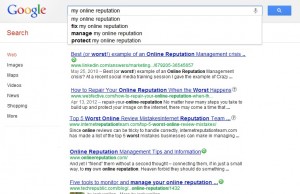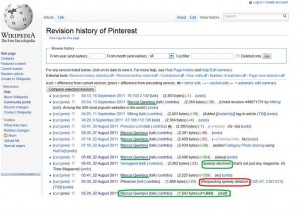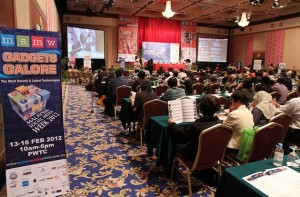A copy of Jay Byrne’s presentation to Talkers 2011, New Media Seminar can be downloaded here:
https://www.jaybyrne.com/wp-content/uploads/2011/06/Talkers-2011-Jay-Byrne.pdf.
I’ve been asked to provide an example of intersecting real world behaviors with new media tactics. So, let’s take Twitter. While some will use Twitter for customer service, others for one-to-one and one-to-network information sharing, the fact remains that most people aren’t using Twitter or going there in their day-to-day interactions.
But, something a significant volume of people do is search and scan news online. Twitter influences what stories we are likely to see in online news aggregator sites (e.g., Google News, Yahoo! News or your local newspaper’s website which pulls in those feeds) and has an influence in traditional search. Your tweets, if properly executed and syndicated, can play a role in this influence. If you want to know more, read on…
To tweet or not to tweet… consider taking two minutes to read this before you answer.
Like websites, then blogs, people have been rushing to Twitter as the next best thing now for a couple of years and often for the reason “because everybody is doing it…” As with anything, our reasons for investing our time and energy should be measurably linked to goals and not just following the crowd. I have this type of conversation with my pre-teen son and daughter every week; I never imagined I’d be having it with multi-billion dollar clients – but in the words of HL Mencken, “Nobody ever went broke underestimating the intelligence of the American people…”
If a goal is to create awareness, linked to opinion formations which eventually support beliefs upon which our target audiences act associated with our organizational or personal goals, then we should consider how and why microblogging (e.g., Twitter, Foursquare, Tumblr or microblogging features on Facebook and LinkedIn) can support that goal.
Like most social spaces, Twitter is first and foremost an “awareness” channel. Using this service you can create direct awareness of content for the people in your network and those to whom you extend your network using specific Twitter platform tactics (#hash tags, @directed tweets and RT re-tweets). However, the real value of Twitter is its power to influence broader awareness outside of the Twitter network where the majority of people reside.
In 2009 Google made a minor investment in Twitter to gain access to their live and full stream of content for use in Google’s search and the Google News aggregator algorithms. Search engine algorithms use a variety of factors to determine what search results appears above others and – this is most important for Twitter and our interests – what news stories to display on top of others in their news aggregator portals (e.g., Google News and Yahoo! News). These algorithms now tap Twitter seeking keywords tied to hyperlinks associated with news to influence what news items show up on top of these news aggregators and the news portals which display their results.
News portals have significant and broad influence – the content from these sites is streamed to hundreds of thousands of local news websites and topic portals where the vast majority of consumers and influential public policy figures get their news today. News and search portals are critical opinion formation spaces which can then lead to desired belief formations in support of our goals.
Twitter influences which stories appear and in what order they appear giving those who have effectively Tweeted first and with the most frequency (syndication) an edge on determining what the rest of the world sees on specific topics. Twitter can drive awareness AND help influence content that determines what opinions the public forms about a given topic.
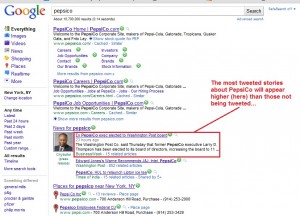
News and search are influenced by Twitter
Now, only a small percentages of Tweets use effective tactics to influence search and news algorithms. If you aren’t able or willing to use these tactics effectively then the ROI on your time and energy will be limited. The two most important to consider are:
1. Inclusion of a hyperlink. On microblogs this typically involves using a URL shortening service like http://bit.ly (my preferred service).
2. Inclusion of a relevant keyword associated with the topic, to which you can also assign a #hash tag. By including the “#” pound sign or hash tag in front of a contiguous string of characters you can alert others on Twitter interested in that topic and create new visibility for your Tweet which can help syndicate your search and news influencing links.
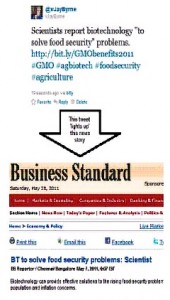
On any given day and for any given topic there may be numerous news reports (these can be from mainstream sources or simply blogs) associated with sustainable agriculture, biotechnology, etc… Typically, stories which have been amplified via Twitter with the following characteristics will have more influence than other stories:
• “First to be tweeted” – links to stories which hit Twitter first frequently appear as the top news. Speed matters.
• Most tweets (and re-tweets) – stories with the highest volume of links from Twitter frequently appear on top. Even if you aren’t an “early tweeter” you can help support those who are by re-Tweeting or re-posting their contents to your Twitter account. Size (volume) matters.
• Weight of tweets – the more people following your tweets (subscribers) gives them more weight. Further, you can add to this weight by linking your Twitter account to your LinkedIn, Facebook or other social media accounts so that your tweets are automatically syndicated to those networks. So “following” one another in our Twitter network and syndication within our other social networks, just like linking to one another’s blogs gives all of our tweets (whether we are tweeting or not) additional influence. Validation (followers) matters.
If you want to influence news and search and are willing to adopt one or more of the tactics which can make that happen, Twitter may provide you with a decent return on investment.
